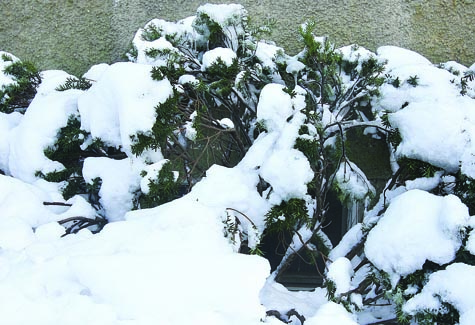Real Estate: Experts warn a rough winter could do a number on plants

You just finished shoveling your driveway. You’re sweaty. Your back hurts.
The last thing you want to do is brush snow off your shrubs.
But experts say that little bit of regular maintenance could mean the difference between healthy vegetation and broken, sickly shrubs and trees come spring.
With moderate temperatures beginning to thaw the region after nearly 60 days of record storms and bitter cold, the blanket of thick white crusty snow has started to recede. That’s a welcome sight, but many homeowners are finding they’re left with some pretty funky looking shrubs bordering their lawns and driveways.
That’s because they left heavy snow on their shrubs and evergreens, which turned into heavy ice that was nearly impossible to remove without damaging limbs and branches. When it finally melted, behold: bent, drooping limbs and even some that break under all that weight.
So, what to do? If your shrubs and landscape trees still have some snow on them, you could carefully try to brush off some snow on a warming day, but that’s about it, local landscapers and nursery owners warn, because you risk permanently damaging the plants.
“First, if you’re not sure” about what to do, “call an expert,” said Lawrence Kaiser of Kaiser Maintenance Inc. in Jamesport, a landscaping company. “Most consultations are free; it’s almost like free advice. But if today was, say, five degrees above zero, it’s not a good day to do anything. I wouldn’t go out and try to tie stuff together that got splayed in the December storm because it’s a good chance it’s all frozen in place right now, because it’s still dormant.”
The best time to try to correct a bent branch or two is soon after a snow storm, before the new shape becomes permanent, he said.
“If there’s a heavy, wet snow, go out there with a broom — not an iron rake or shovel — and sweep everything off,” Mr. Kaiser said. “If they are still bent or splayed, get a small role of sisal twine and tie the multiple trunks” together for mutual support.
There’s still time to help bent shrubs and evergreens recover before spring. “Arborvitae should be tied together to prevent them from splaying apart out from the heavy snow load,” Mr. Kaiser said. “I get calls from a lot of people whose evergreens have splayed. You have to tie it up before the spring flush, because it will harden off. In other words, it will stay like that” — splayed, that is — “and it will continue to grow like that.”
He warned against plastic and other synthetic ties like “those black plastic ones,” which won’t give way to new growth and then biodegrade. They “will start digging into the cardiovascular system” of growing plants, choking them to death — so use natural fibers for your support system.
Chris Mohr of Chris Mohr Landcaping in Cutchogue also warned against messing with frozen greenery.
“Some of the stuff will bounce back because of the warm weather; most will need some pruning,” he said. “You can’t really tie anything back if it’s still cold; you don’t want to cause any more damage.”
He said some shrubs may have to be tied to stakes come spring. He mentioned several Leyland cypresses he’d seen severely bent over, in some cases blocking driveways.
New growth in the coming year will solve some problems caused by winter snows. “Don’t trim them in the fall,” Mr. Mohr said. “Leave it on the long side.”
For the rest of this winter, and definitely for next year, anti-desiccant spray can help. It’s a latex film that’s sprayed over the leaves of conifers and evergreens. It leaves a waxy coating that keeps ice from adhering to the shrubs and trees.
“That’s one thing people could do during the winter, starting in November, as a preventative measure,” said Lou Carocciola, owner of Shade Tree Nursery. “That’s something people could do a couple of times during the winter, starting in November. You can apply it as long as the material dries on the plants prior to a freeze.”
Another thing to do, he noted, is wrap plants in burlap before winter snows begin.
He’s had a hard time keeping all his shrubs free of snow this winter. With hundreds of thousands of plants to tend to, it’s an impossible task. “A lot of the fields we don’t have access to because the snow has been so heavy we can’t get in there. We tried early on but it got too difficult. It’s hard because a lot of the bottom foliage is already bent,” he said. Most of the damage won’t be known until spring, when irreparable burn becomes evident, he said.
He suggested fertilizing plants in the spring “if they’re kind of brown-looking.” And waiting until April to prune.
“In March don’t be in such a rush to go out there and prune,” he said. “Wait to see if the buds are still [healthy] and new foliage is going to flush from them. And then go out and do your pruning.
As for Mr. Carocciola’s business, he said he expects a “short lived” up-tick in sales this spring, but not solely because of people buying replacements for damaged plants.
“People have been trapped so they probably can’t wait to get out in the garden, and out in the garden center,” he said. “We want to generate sales because people want to get out and plant things. We would rather have a thriving economy than have to rely on storm damages to make a living.”



